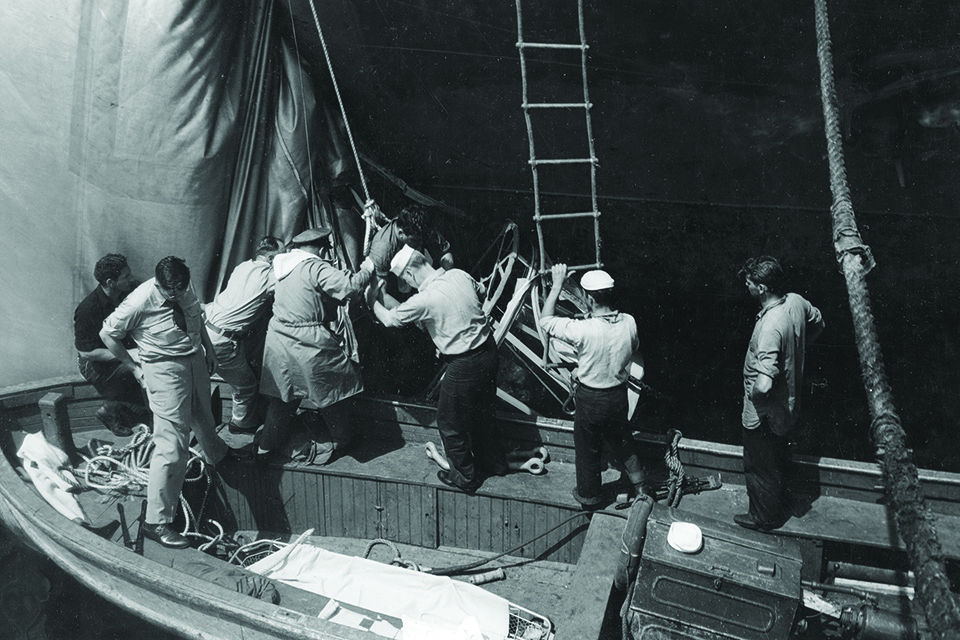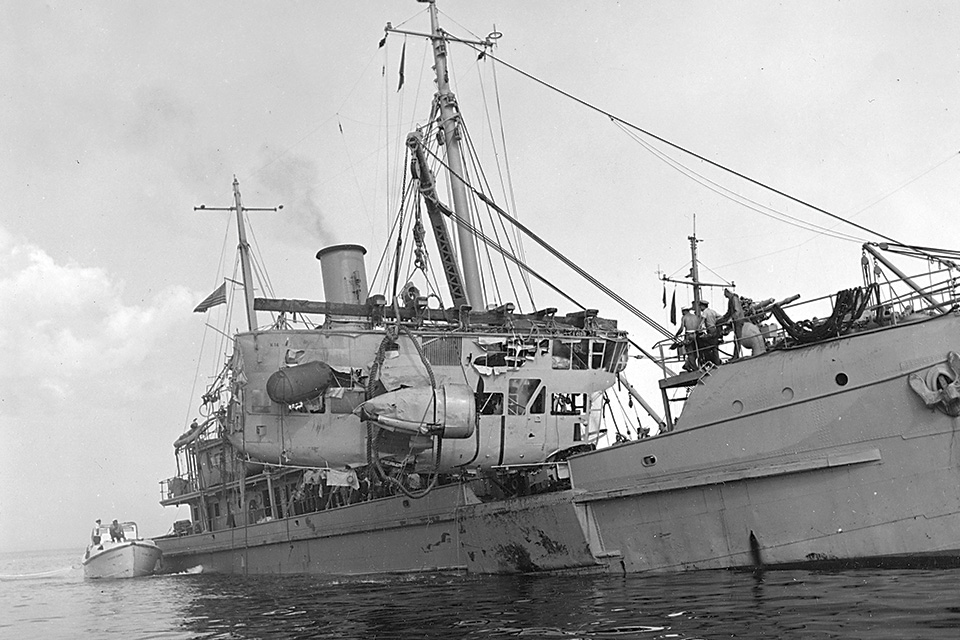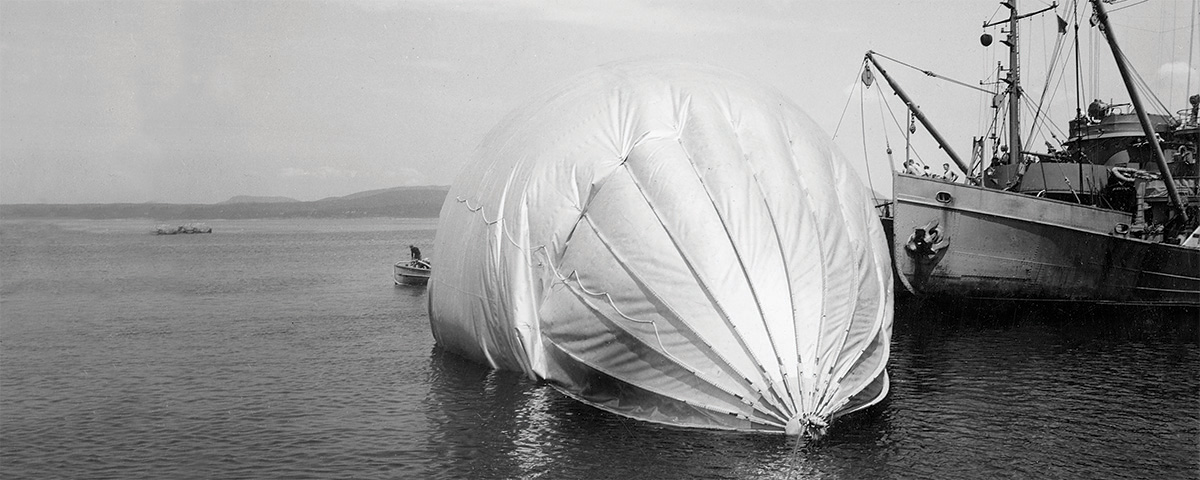Was the loss of a patrol blimp off Maine in 1944 the result of pilot error, as the U.S. Navy maintains to this day, or was it due to a battle with a German U-boat?
When the U.S. Navy blimp K-14 went down in the Gulf of Maine in July 1944, it left behind a series of unanswered questions. The most controversial of these was whether K-14 had accidentally crashed, as a Navy inquiry concluded, or had been shot down by a German submarine. That question has never been sufficiently resolved.
The blimp was conducting an anti-submarine patrol on July 2 when it radioed a routine check-in call around 9:20 p.m. K-14 was not heard from again, and is believed to have crashed into the ocean at about 10 p.m. Six of its 10 crewmen perished in the crash, and the survivors clung to the tail fins of the wreck for more than six hours before being located and rescued. Evidence found on K-14’s salvaged gas envelope and in its gondola indicated that shots had been fired both from, and likely at, the airship. Meanwhile military and civilian witnesses reported hearing gunfire and explosions around the estimated time of the crash.
Following the incident, the surviving crew members were ordered not to talk about it, orders the Navy has never rescinded. To this day, the wreck is officially credited to “pilot error.”
That German U-boats were in the area has never been disputed. U-233 was on a minelaying mission off nearby Nova Scotia at the time, and was sunk by American destroyer escorts three days after K-14 went down. By June 1942 alone, six months after the United States entered the war, 171 American vessels had been torpedoed off the East Coast, and by the end of the year U-boats had sunk 454 American ships. As part of its effort to counteract this submarine threat, the Navy began launching lighter-than-air craft to patrol the immediate offshore waters. These airships could fly lower and much more slowly and silently than airplanes. When Japan bombed Pearl Harbor and launched the U.S. into the war, the only airships then in service—mostly trainers—included four K-type blimps that Goodyear had built between 1938 and 1941. They were quickly transferred to patrol duties.
The K-type blimps were 251 feet long and were powered by two 425-hp Pratt & Whitney R-1340 Wasp aircraft engines. They carried a crew of nine or 10 men and were armed with one .50-caliber M2 Browning machine gun and up to four 350-pound Mark 47 depth charges. They could reach a maximum speed of 78 mph and had a range of 2,025 miles. The blimps’ mission was to locate enemy submarines and then call for help; their limited armament was considered too light to directly engage a U-boat.
On the morning of July 2, 1944, Earnest and Merrill Stanley, two lobstermen working out of Southwest Harbor on Mount Desert Island, Maine, sighted a submarine at about 10:45 some 13 miles southeast of nearby Baker Island. They said they had spied a periscope sticking out of the water several hundred yards away, moving south. The weather at the time was clear and the seas calm with little or no wind. When the men returned to port that afternoon, they notified the Coast Guard station in Southwest Harbor of the sighting.
To search for the sub, the Navy sent surface vessels and launched K-14 at 5 p.m. from the naval air station in South Weymouth, Mass. The blimp arrived in the search area around 9 p.m. and dropped to an altitude of between 100 and 200 feet, where it deployed a magnetic anomaly detector that it pulled through the water to sense any large mass of steel such as a submarine. After its check-in call around 9:20, all attempts to contact K-14 failed, and at 4 a.m. surface vessels and aircraft in the area were alerted to keep an eye out for the missing blimp.

The four surviving crewmen later reported that K-14 was flying at 250 feet when it suddenly lost altitude, did not respond to attempts to right it and crashed into the water. Copilot Ensign Ernest Sharp said he was at the elevator controls at the time. “I reached up to dim the lights, sat down, and saw the indicator at 200 feet,” he reported. “I gave it the throttle and the nose came up a bit…[but] the first thing I knew she was going in.”
According to the survivors, the airship’s gondola quickly began to fill with seawater, and the deflating gas envelope sagged and settled over the gondola on the ocean’s surface. The ship’s engines dipped below the surface, choked and died. As water poured into K-14’s gondola, the trapped crew struggled to find an exit. Most of the windows did not open, and the main hatch was sealed with a metal bar on the outside to protect crewmen from accidently falling out. Five members of the crew were nonetheless able to escape and reach the surface. Among them was Aviation Metalsmith 3rd Class Edward J. Drzewiecki, who was “weak and unresponsive” and died later that night. The five remaining crew members never cleared the wreck and drowned.
The survivors clung to the craft’s tail fins and the still-floating section of its envelope, trying to stay warm in the 55-degree water. Finally, at 4:55 a.m., the Navy patrol craft Patriot spotted the downed blimp east of Mount Desert Rock and about 25 miles south of Bar Harbor. The survivors were rescued and taken to the hospital at Bar Harbor, allegedly with orders not to talk to anyone about what had happened.
The airship’s remains were towed onto the shore at Bunker Cove on Islesford, another of the many islands dotting the area. The cove had been cleared of small boats and fishermen beforehand, but the island’s residents were allowed to remain. There the blimp’s gondola was found to be 95 percent wrecked, with the bodies of two dead crewmen still aboard. (The bodies of the two other crewmen were never found.) Preliminary examination of the wreckage also revealed two depth charges missing and 15 to 20 .50-caliber shell casings in the gondola. There were also what appeared to be bullet holes in the underside of the K-14 gas bag near the gondola, which were consistent with the caliber of anti-aircraft ammunition fired from German submarines. It was also discovered during the salvage operation that the entire rear portion of the blimp’s gas bag was missing, something not known to have happened before to a K-type blimp.

As the investigation widened, a naval reserve lieutenant who had been on patrol at the time of crash reported that “he and all hands on his ship heard the explosion of two depth charges to seaward” about 40 minutes before the estimated time of the blimp crash. Warrant Officer W. Meytrott was aboard a ship stationed off Schoodic Point when he and three other men “distinctly heard what sounded like six pom-pom shots, possibly from a 20mm gun” at about 9:52 p.m. He recalled seeing the blimp a half-hour earlier, heading from Schoodic Point toward the area where it crashed. He estimated K-14 would have been in the area from which he had heard the gunfire.
Local fishermen reported they had seen flashes in the distance and heard two explosions, while three men stationed on another nearby island also reported hearing gunfire and an explosion, as did some area residents. Arlene Spurling, who had grown up in Southwest Harbor and was a teenager at the time, told the Mount Desert Islander newspaper, which in 2012 ran a series of articles on the K-14 incident, that she was sitting on the front porch of her home when there were flashes to the east and “we heard shots and the thuds of large explosions.”
In all, a secret Navy operational intelligence report filed on July 6 listed eight witnesses who reported gunfire and explosions around the time of the crash, and concluded the loss of K-14 “could have been as a result of enemy action.”
The Mount Desert Islander also reported in its 2012 series that unbeknown to the four K-14 survivors, a stenographer had been hidden in proximity to the room where they were receiving medical aid to record anything they said among themselves—an unusual security measure. “No record of those conversations has ever surfaced,” the newspaper noted, “although the Bar Harbor base’s commander at the time said in his memoir that ‘nothing’ differed from the official transcript.”
The alleged “bullet holes” in the blimp’s gas bag, the Navy suggested, were probably caused by grappling hooks used in the salvage operation, and the missing depth charges could have been jettisoned in the moments before the crash as a safety precaution. It has offered no explanation for the shell casings found in the K-14 gondola or for the eyewitness reports of gunshots and explosions.
The Navy’s final explanation for the crash was that the blimp was flown into the water during low-level operations. Although the Navy blamed pilot error, none of K-14’s survivors was ever court-martialed or disciplined for the alleged error. It is generally accepted that the incident was swept under the rug to prevent panic among the public and to maintain the morale of blimp crews.
That explanation made sense in 1944, but it’s now 73 years later.
Fred Morin of Plymouth, Mass., who has been researching the K-14 incident for more than a decade, is among the investigators who insist that the available evidence clearly shows the blimp was shot down. Morin has interviewed survivors of the crash, and claims that copilot Carl Levine admitted to him that K-14 had been attacked. When the two men were alone during an interview, Morin said he asked Levine to tell him outright what had happened. “Of course we were shot down,” Morin said Levine replied. “How do you think we ended up in the water?” That quote, however, cannot be independently verified.
Morin has questioned the Navy’s refusal to release the results of several inquiries into the accident. Researchers have also pointed to a menu from the officers’ club at the Bar Harbor naval base that was taken by one of K-14’s surviving crewmen as a souvenir. One of the rescue personnel signed the menu with the notation, “Wishing you the best of everything although you’re the only one that surprised a Bosch sub,” an indication that both the K-14 crew and its rescuers knew the blimp had been attacked and shot down.
The shell casings in the gondola, the missing depth charges and the damaged gas envelope, plus at least eight eyewitness reports and an unverified claim by one of the surviving crew members make a strong case that K-14 was attacked that July night and brought down by a German submarine. So why, more than seven decades later, Morin and other investigators ask, is the Navy still clinging to an explanation that—almost from the time it was first made—had more holes than were found in the K-14 gas bag?
“[The Navy’s] excuses do not hold water and can be refuted relatively easily,” Morin said. “It would be to their credit to give out a few Purple Hearts and close the matter.”
Chuck Lyons is a retired newspaper editor and a freelance writer whose articles have appeared in numerous periodicals. Further reading: Forgotten Weapon: U.S. Navy Airships and the U-boat War, by William F. Althoff.
This feature appeared in the November 2017 issue of Aviation History Magazine. Subscribe today!

